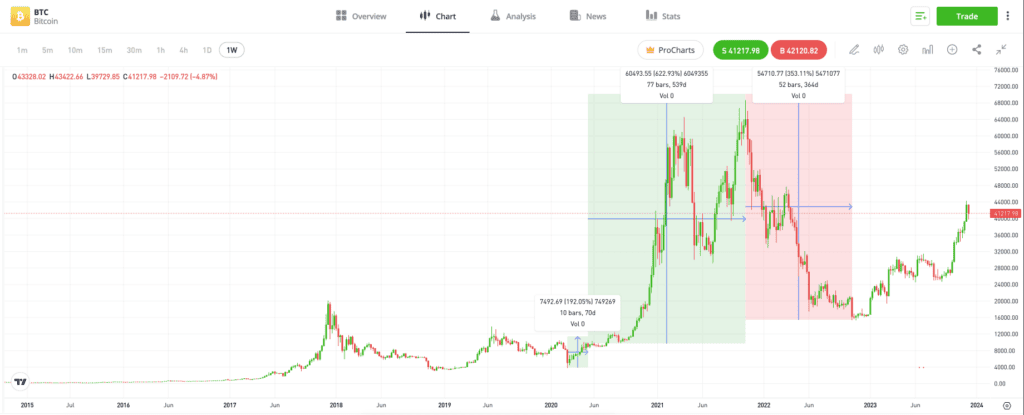The Bitcoin halving event and subsequent four-year cycle can have a significant impact on prices in the crypto market. Learn some key strategies for trading the four-year cycle, and discover how market sentiment and psychological factors can impact trading decisions.
With the Bitcoin halving occurring approximately every four years and demonstrating such a strong influence on the price of bitcoin, it is worth studying previous halving events when making strategic decisions.
There have been three previous halving events, which have demonstrated recurring themes. If these trends and price movements repeat themselves in the upcoming Bitcoin halving event, they could potentially present some good trading opportunities.

Four-year cycle strategies
Bitcoin’s four-year cycle occurs as a result of the halving, which sees Bitcoin mining rewards cut in half every time 210,000 blocks are created. The halving event causes increased volatility and significant price fluctuations, which have been proven to be cyclic in nature, with the bitcoin price following patterns over a four-year period.
To create and implement a strong trading strategy, it is important to know more about the different stages of Bitcoin’s four-year cycle:
Pre-halving — As the halving approaches, media and retail interest rise in anticipation of a new bull market. This interest and influx of capital have previously led to a pre-emptive bitcoin price increase.
Post-halving — Like all markets, bitcoin’s price is ultimately determined by the forces of supply and demand. Reducing the supply of new bitcoins by 50% typically confirms the start of a new bull market.
Parabolic peak — As buying pressure builds and the price of bitcoin rises, euphoria often grows, pushing the price higher. Additional interest in the wider crypto market typically sees money flowing into altcoins such as Ethereum, Cardano and Polygon, among others.
Bear phase — As bitcoin investors take profits or shy away from the cryptoasset’s higher valuation, the price has historically witnessed a slump. This phase, often referred to as the “crypto bear market,” can last for months or years.
Accumulation phase — As price consolidates at a new, lower level, long-term investors will often take the opportunity to “buy the dip” in anticipation of the next Bitcoin halving.
Lessons from the 2020 Bitcoin halving
Studying the effects of the 2020 halving can potentially offer insights into how a future halving might act as a catalyst for price movements.

For illustration purposes only. Past performance is not an indication of future results.
Source: eToro
The above BTC price chart demonstrates some of the stages of the four-year cycle more clearly.
The 2020 halving took place on May 11th, although a pre-halving rally occurred from March that same year, with the price of bitcoin witnessing a 150% increase during that time.
The bitcoin price saw two huge spikes in the post-halving phase of the cycle, eventually reaching a new all-time high of more than $69,000 in November 2021.
The bear market that followed November’s price peak lasted for more than a year, with bitcoin experiencing a 75% decline in value.
Tip: Past performance is not a guarantee of future price moves, but historical trends can help to provide some insights.

Psychological factors that impact bitcoin trading decisions
To understand exactly how the Bitcoin halving creates a four-year cycle, it is important to consider some of the psychological factors that might influence investment decisions.
Fear and greed
All investors are at risk of feeling fear and greed when investing, although these feelings can be exacerbated by the significant returns made by some bitcoin investors during the post-halving price surge.
In crypto, “FOMO” — otherwise known as the “fear of missing out” — can cause some investors to chase trends or remain in positions for too long, in the hope of making additional profits.
In addition, when upward trends reverse, criticisms surrounding the viability and longevity of the crypto sector resurface, which can cause increased selling pressure.
Self-fulfilling prophecies
The widespread reporting of the Bitcoin halving process, and the way in which it follows a pattern, suggests that Bitcoin’s four-year cycle is a self-fulfilling prophecy. This means that the price moves happen, at least in part, because market participants think that they will.
There is also a common saying among investors: “Buy the rumour, sell the fact.” Potential upcoming events or changes can be priced into the market before an official announcement is made. This can cause people to take profit following the announcement, forcing prices lower, even if the headline is a positive one. The same can also be said for bad news.
Tip: Investors who take a long-term view on Bitcoin’s prospects and resist the temptation to sell positions are called “HODLers.”
Market sentiment factors that impact bitcoin trading decisions
Investor sentiment can influence prices in all markets, including the cryptocurrency market.
New investors, especially those focused on more traditional asset classes, often become more interested in bitcoin and other cryptoassets as the halving gains mainstream media attention. Any market that experiences an inflow of capital will often witness price movements, typically to the upside.
Speculative investors who are trading the halving event, rather than adopting a buy-and-hold approach, will likely be more easily shaken out of positions compared to long-term investors. Higher numbers of speculative investors can lead to more dramatic price crashes and increased volatility.
External impacts on bitcoin trading decisions
Although the Bitcoin halving can have a significant impact on the price of bitcoin, other factors also apply.
Fundamental analysis factors have been shown to influence the price of bitcoin historically. For example, moves made by crypto regulators could potentially influence market prices.
In 2019, China restricted the trading and mining of Bitcoin, resulting in a significant price crash. On the other hand, the relaxation of regulations in certain countries could encourage increased mainstream crypto adoption, which might lead to price fluctuations.

Final thoughts
The Bitcoin halving generates additional interest in bitcoin and the wider crypto sector. It is a predetermined event that follows set protocols, allowing traders to prepare strategies in advance.
Nothing is ever guaranteed in the financial markets, especially in crypto, but carrying out research for key crypto events, such as the halving, is one of the golden rules of investing.
Visit the eToro Academy to learn how to create trading strategies.
FAQs
- Will all Bitcoin halvings take place every four years?
-
The timing of future halving events is determined by the rate at which miners successfully extract new blocks. At its current rate, the halving takes place approximately every four years. However, if the block production rate were to double, for example, then the halving event would take place every two years, on average.
- Can you day trade bitcoin?
-
Yes, it is possible to day trade bitcoin and buy and sell positions on the same day. Due to the significant volatility of the crypto market, there is a chance that traders will see gains or losses of more than 10% within a single day.
- How many bitcoins are mined each day?
-
On average, 900 new coins are mined on the Bitcoin blockchain each day. Using the current reward rate for Bitcoin, this equates to roughly 144 new blocks created every 24 hours.
This communication is for information and education purposes only and should not be taken as investment advice, a personal recommendation, or an offer of, or solicitation to buy or sell, any financial instruments.
This material has been prepared without taking into account any particular recipient’s investment objectives or financial situation and has not been prepared in accordance with the legal and regulatory requirements to promote independent research. Any references to past or future performance of a financial instrument, index or a packaged investment product are not, and should not be taken as, a reliable indicator of future results.
eToro makes no representation and assumes no liability as to the accuracy or completeness of the content of this publication.
Cryptoasset investing is highly volatile and unregulated in the UK and some EU countries. No consumer protection. Tax on profits may apply.


